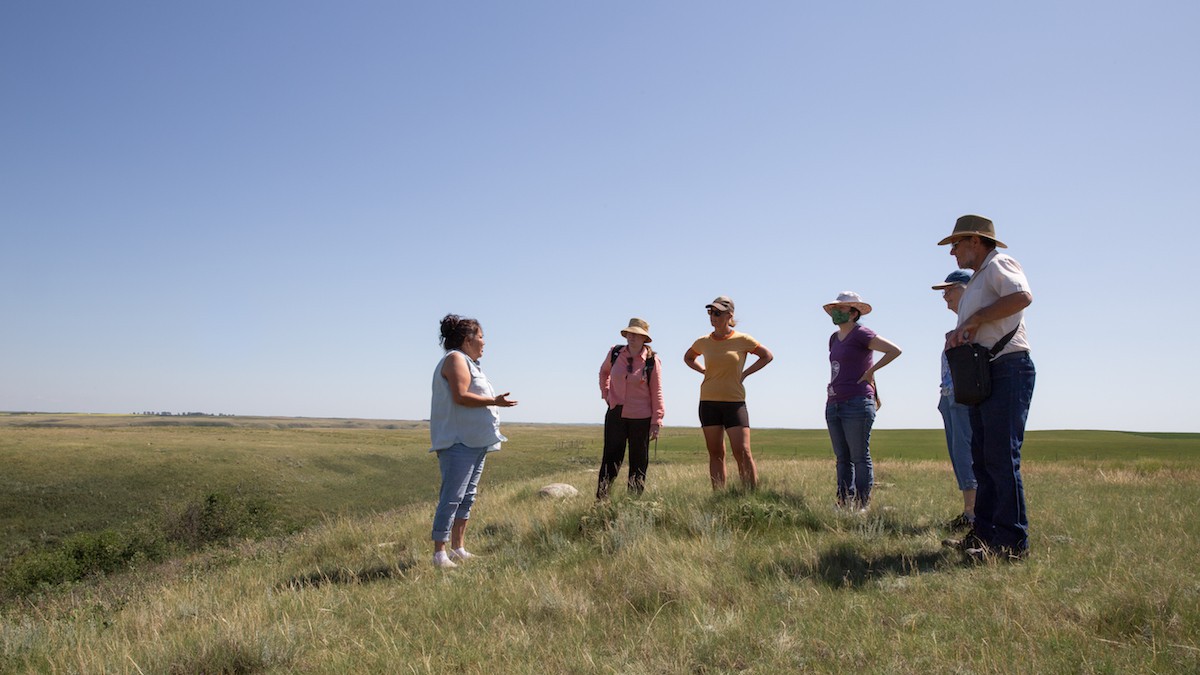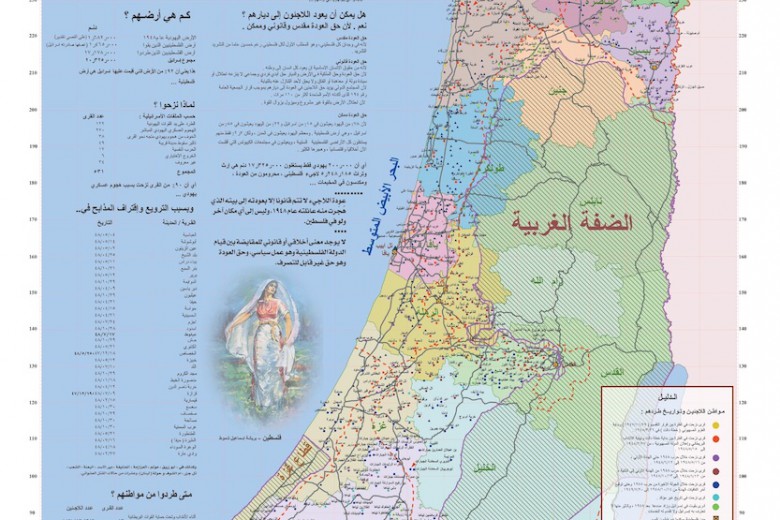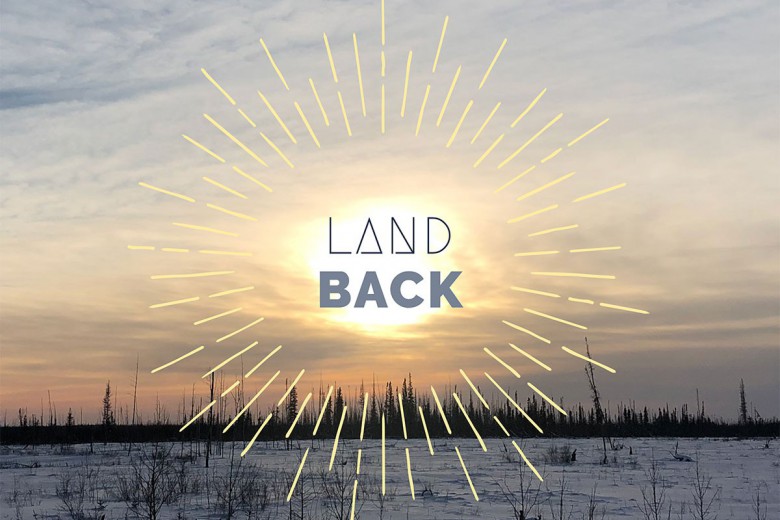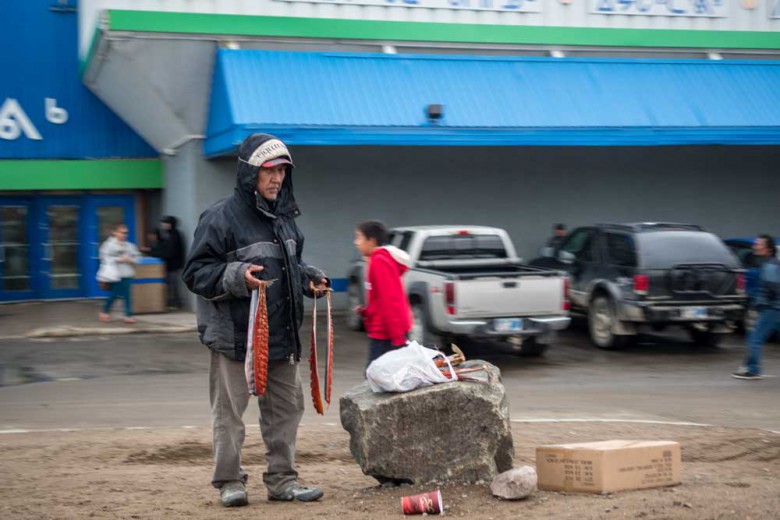On August 9, 2020, a small group of Indigenous people and settlers gathered at a farm on the edge of Bladworth, Saskatchewan, near the border of Treaty 4 and Treaty 6. Elder Ross Gardypie said a prayer in Cree for the Pipe Ceremony. The women prepared food for lunch, and the men laid it out on a tarp in the yard, close to the earth, as is the custom during a feast. There was conversation and laughter. A while later, the group walked out into a small pasture of 20 acres, where farming couple Mary Smillie and Ian McCreary take their cull cows in the summer. Everyone broke off in different directions to walk on the land for a time. Knowledge Keeper Kevin wâsakâyâsiw Lewis and his grandmother found dozens of medicinal plants around the trees. One couple found horsemint.
“That was one of the best land-sharing events we had,” says Amy Seesequasis, who coordinated the event, “because of the ceremonial aspect and the fact that you had non-Indigenous and Indigenous people in a ceremony together. That for me was something I never thought I’d ever see in my life.”
It’s an unassuming scene, but one that signifies the beginning of a new way of sharing land on the Prairies. The gathering was hosted by the Treaty Land Sharing Network (TLSN), a grassroots group of settler farmers, ranchers, and other landholders willing to share their land with Indigenous land users. According to its brochure, the group is “committed to implementing the Treaty relationship, engaging in ongoing learning together as we practice being Treaty people, and establishing a different way forward for rural Saskatchewan.”
“We should know how to share. For goodness sakes, that’s a kindergarten behaviour,” says Smillie, who is a retired nurse and community health facilitator. “But […] we have no facility for that, no mechanism for land sharing.”
A counterpoint
The idea for the TLSN arose in response to two events that happened on the Saskatchewan prairies between 2016 and 2018.
The first was the killing of Colten Boushie on Gerald Stanley’s farm in August 2016. Two years later, Stanley would stand trial and subsequently be acquitted by an all-white jury. In the months leading up to and after Stanley’s trial, racism and hostility toward Indigenous communities reached a fever pitch in Saskatchewan. A Facebook group called “Farmers with Firearms” formed a month after Boushie’s killing and amassed 5,000 members. A member of a private RCMP Facebook group claimed that Boushie “got what he deserved.” The racism made its way off social media, into rural society more broadly. In 2017, only months after Boushie’s killing, the Saskatchewan Association of Rural Municipalities approved a resolution to lobby the government “to expand the rights and justification for an individual to defend or protect himself, herself, and person under their care and their property.” The idea was that one should be able to shoot someone in order to protect private property.
“It was horrid out here in rural Saskatchewan,” says Smillie.
At the same time, the Saskatchewan government was actively selling off Crown land, something it has done for well over the last decade. Between 2008 and 2020, over one million acres of Crown lands were sold, with a record amount – 231,000 acres – sold in 2017. The sale of these lands – especially unoccupied Crown land, on which First Nations peoples have the right, enshrined in the numbered treaties, to hunt and gather year-round – is decried by the Federation of Sovereign Indigenous Nations. The FSIN says the government is not consulting First Nations about the sale of Crown lands as is necessary to address outstanding obligations under the 1992 Treaty Land Entitlement Framework Agreement.
“We have roles and responsibilities as Treaty people and obligations to teach each other respectfully and give each other fair access, fair space, and have that mutual benefit.”
Valerie Zink, a community organizer and documentary storyteller, saw a need for rural settlers to counteract this racism and erosion of Treaty Rights. Zink, who grew up on a dairy farm in the foothills of Alberta, wondered how landholders might share land with their Indigenous neighbours. She knew other landholders who felt similarly but didn’t know what to do. In July 2018, Zink met with Saulteaux and Cree hunter Philip Brass in Fort Qu’Appelle. Brass suggested an idea that Smillie calls “elegantly simple in its design”: build a network of landholders willing to provide access to Indigenous land users.
The idea developed into its current form: along with sharing contact information within the network, members can publicly indicate their support by putting up signs on their land, a bold counterpoint to the ubiquitous “no trespassing” signs on fences across rural Saskatchewan.
After two organizing events at Wanuskewin and Fort Qu’Appelle in 2019, both Smillie and Seesequasis joined the nascent network in early 2020.
Today, Seesequasis coordinates speakers for the network’s events. A Cree and Métis artist and mother from Beardy’s and Okemasis’ First Nation, she is the director of public education for the Office of the Treaty Commissioner, which facilitates treaty education in Saskatchewan. TLSN and OTC have partnered on grant applications and co-hosted virtual events. At the gathering on Smillie’s farm in August, the OTC and TLSN entered a formal partnership through a Pipe Ceremony and feast.
“[These women] wanting to be able to create a safe and inclusive society is what really resonated with me,” Seesequasis recalls. “We have roles and responsibilities as Treaty people and obligations to teach each other respectfully and give each other fair access, fair space, and have that mutual benefit.”
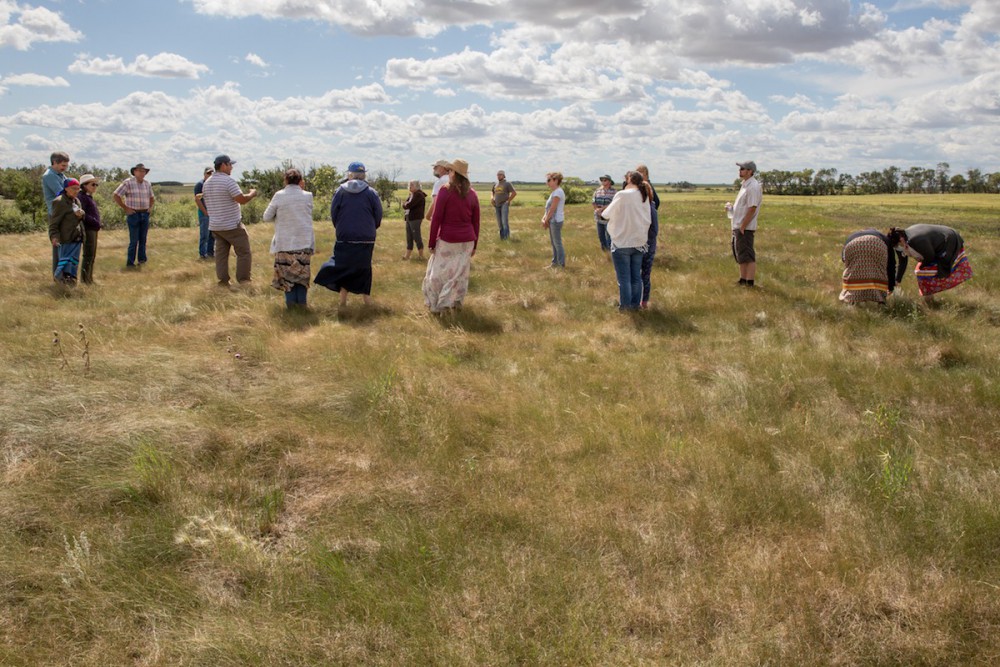
No reconciliation without land
Rural hostility to Indigenous movement across the Plains is not new. The Indian Act of 1876 and the 1885 pass system confined Plains Peoples to reserves, parcels of land much smaller than their traditional territories. Starvation policies were used to force Plains Peoples into treaties with the Crown.
Along with annual sales of Crown land to the highest bidder, in fall 2018, the Saskatchewan government passed amendments to its trespass legislation, which, if enacted, would place the onus on land users to obtain consent from the landowner before entering their land. For Brass, asking permission to hunt is an example of a paternalistic paradigm that privileges settlers and ignores Indigenous rights.
“That’s the injury on top of insult,” says Brass. “It’s this burning frustration that takes a toll on the body and mind of Indigenous peoples. It’s because we are occupied, our territory is occupied, altered. […] It’s infuriating.”
Brass tells me he’s seen hostility toward Indigenous hunters intensify in recent years. He knows of hunters being followed by trucks that tail them bumper-to-bumper. He says he was questioned by settlers while skinning an elk. They asked his name, took his licence plate number, and asked which community he came from. In a text, he recalls a story of one hunter returning to his vehicle to discover the phrase “FUCK OFF INDIAN” spray-painted on the gravel in front of his truck door.
“No ecosystem is whole and functioning unless it has Indigenous Peoples accessing it.”
Because the Crown land around his reserve was sold off, Brass drives to the rural municipality of Garry, 45 minutes north-east of Peepeekisis, to hunt on community pastures and provincial wildlife lands. But farmers have received permission from the government to graze cattle on a parcel of wildlife land in the area that is primarily elk habitat. Brass worries this will lead to heated interactions.
“They seem to have the notion that they’re the authority on wildlife lands, to boot Indigenous Peoples out,” says Brass. “It’s created a powder keg for confrontation in that area.”
Brass, who is an Indigenous adviser for the Nature Conservancy of Canada, argues that settler ignorance about Indigenous hunting is part of the problem. Unlike most settler hunters who hunt for sport, he says hunting is the foundation of Indigenous culture and plays an important role in the prairie ecosystem.
“It was buffalo and Indigenous Peoples and [their] use of fire, working in cohort together over millennia, that brought native prairie into existence throughout the Great Plains,” he says. “No ecosystem is whole and functioning unless it has Indigenous Peoples accessing it. The amount of animals that we take and the harvesting of plants is essential to the health of an ecosystem and vice versa. We can’t thrive, our health won’t thrive, our languages won’t survive, unless we exercise land-based life practices in our home territories.”
Brass argues hunting in his community is also a means of survival due to systemic poverty on reserves. This means it happens on back roads on the way to town, not on a recreational trip many can’t afford.
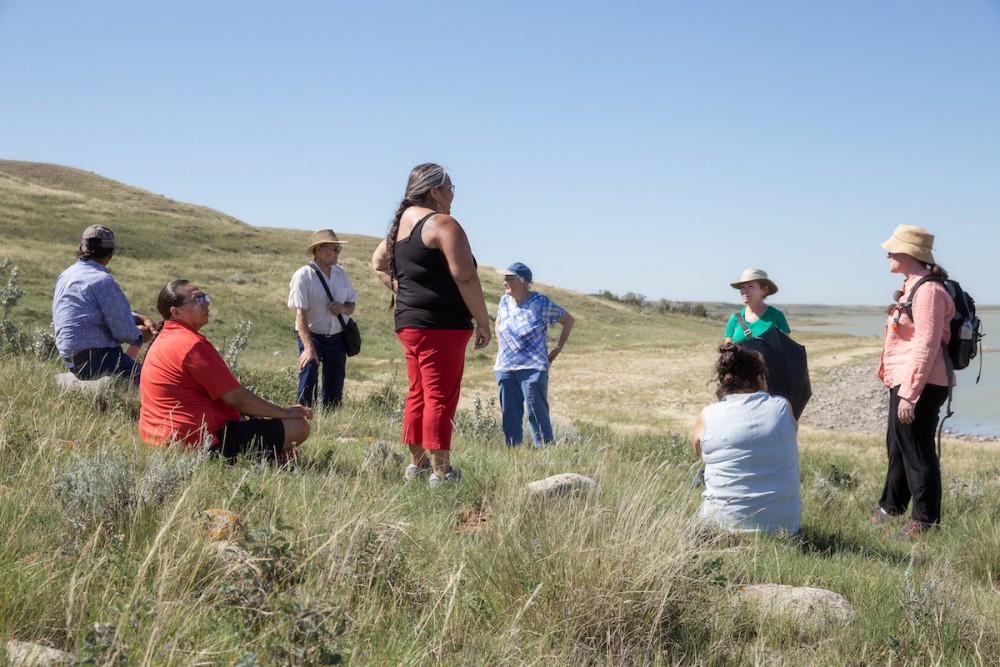
Treaty people – listening and learning
Along with land-sharing events, the TLSN committee facilitates virtual events to educate settler members about Indigenous relationships to land. Smillie facilitated a book club on Robin Wall Kimmerer’s Braiding Sweetgrass. Seesequasis organized an event on plant identification, so farmers and ranchers can identify plants on their land that Indigenous gatherers might be interested in harvesting. Another was on navigating difficult conversations with neighbours over the TLSN signs, which the network plans to post this summer.
Over the past two years, the network has outlined its principles and held land-sharing events – but the real test will happen this summer, as TLSN signs are posted and Indigenous people start to access shared land outside of formal events. The group continues to have conversations around the expectations of both landholders and land users. While most landholders welcome people gathering medicinal plants and berries, some remain wary about hunting. Smillie tells me that she and her husband are happy to have hunters on their land as long as their cattle are not out and their fences aren’t driven over, which they’ve experienced in the past. They appreciate when people call and ask first. So far the network encourages access on foot and discourages open fires unless all parties agree to them.
Brass advocates for unhindered land access within the network, which includes the ability to hunt without asking permission. “Reconciliation isn’t about feel-goody, sitting-around kumbaya scenarios. It’s about simply relinquishing your power and privilege on land that you occupy and acknowledging that the fee-simple land […] system […] is based on theft.”
“They seem to have the notion that they’re the authority on wildlife lands, to boot Indigenous Peoples out,” says Brass. “It’s created a powder keg for confrontation in that area.”
Seesequasis, too, agrees that hunting and gathering in her territory is part of her People’s inherent right to self-government, which predates the imposition of colonial laws. But she says it was the Indian Act that stripped the rights of Plains Peoples to roam freely in their territories and codified discriminatory practices.
“Reconciliation, I think, would be recognizing the true territory of people,” she says. “I think that’s starting to happen when we do the land acknowledgements, but that’s just skimming the surface. We have to get more into the honouring and recognizing whose land belongs to whom. It belongs to all of us, but Indigenous people have an inherent right to it because their livelihood is based on it.”
Seesequasis sees even the TLSN’s grassroots conversations around land as a powerful thing, particularly when “reconciliation” at the government level so often focuses on programs and not on land. Even the Truth and Reconciliation Commission’s 94 Calls to Action do not mention returning land to Indigenous jurisdiction, something the current Land Back movement advocates.
“The fact that people in the network are recognizing that land is part of that conversation is really important,” she says, “because if the momentum keeps carrying, it’s going to show people at those higher levels, ‘Look what the people at the grassroots level are doing. […] Maybe we better change our lens, our focus.’”

What the land offers everyone
Joel Mowchenko’s family has farmed near Mossbank, Saskatchewan, since 1909. Mowchenko lives in Moose Jaw, but his brother-in-law manages the 1,400 acres of the organic mixed farm. Connected to the TLSN through friends who farm near North Battleford, he posted a video showing his land to the network’s Facebook page in June 2020. Barbara Lavallee, an Indigenous environment monitor, posted in a response that she noticed significant features on the native prairie. Soon after, Zink asked Mowchenko to host the first land-sharing event on July 22, 2020.
At the time, “What [role] potential process farmers and land title holders can play in reconciliation was a big question for me,” says Mowchenko. “I didn’t know what steps could be taken to move forward in a positive direction.”
At the gathering, he says Lavallee pointed out a rock pile on the property. Mowchenko’s father told him the pile was put there by settlers, but Lavallee told him to look at it from a different direction. The pile extended further along the coulee and the rocks were a uniform size – all signs it was part of a buffalo run over the coulee. For thousands of years, Indigenous Peoples hunted buffalo by driving them off cliffs and coulees lined with cairns or stones. The animals’ legs were broken by the fall, making them easy to kill and then process at the bottom of the run. Mowchenko said Lavallee thought the remains of a kill site were probably at the bottom of the hill.
“I looked at it and said, ‘How can I not have seen that before?’” Mowchenko recalls. “It was fantastic learning that.”
Joely BigEagle-Kequahtooway, a Regina artist and founder of the Buffalo People Arts Institute, told him that burying buffalo skulls near anthills was an effective way of cleaning the bone before using them in Sundance and Sweat Lodge ceremonies: the ants eat the flesh without damaging the structure.
“We have to open up these lands because there’s so much more to discover than what Ian and I or our kids [are] going to,” she explains. “We have such a narrow view of what’s here.”
When settlers consider land sharing, Mowchenko explains, they often approach it with a zero-sum mentality: “they assume […] someone else will get more and they will have less.” But after hosting the land-sharing event in July, his mindset changed. Having others use anthills and gather sage does not affect him at all, and hunters would help him manage species that sometimes damage crops. “This would be a win-win,” he says.
Smillie had a similar reaction to peoples’ discoveries in her pasture. “We have to open up these lands because there’s so much more to discover than what Ian and I or our kids [are] going to,” she explains. “We have such a narrow view of what’s here.”
Seesequasis hopes that once TLSN’s new website is up this summer, the committee can spread word about the network by sharing it with Indigenous communities, rural municipalities, and towns. She says the Confederacy of Treaty Six First Nations has reached out to her about forming a network in Alberta. For now, the TLSN remains Saskatchewan-focused since the OTC is mandated to serve the province – but Seesequasis notes that provincial borders don’t constrain treaties.
The TLSN plans to officially launch in June 2021 with another outdoor gathering. The network signs will also be passed out to landholders at the launch. TLSN members hope that, in the best cases, the signs create opportunities for more Indigenous movement within traditional territories and, at the very least, are symbols of peace and reminders of treaty intent in a landscape altered by settler dominance.


